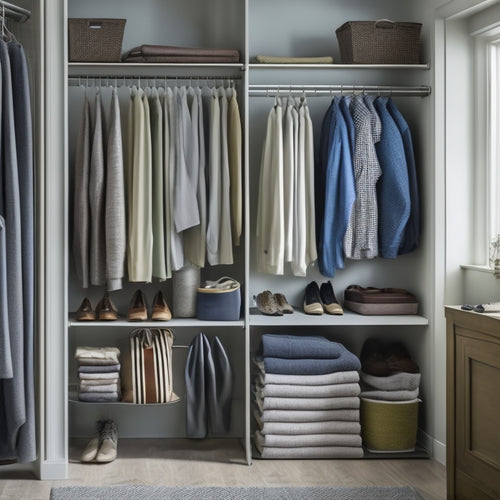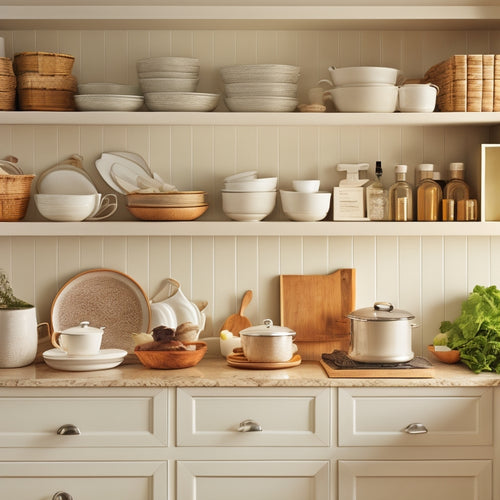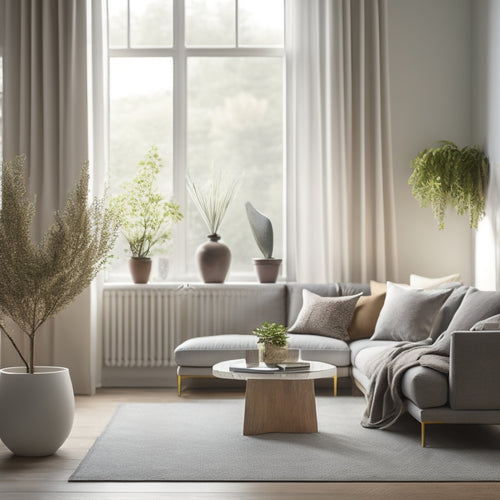
Why Kids' Closets Need Custom Organization Systems
Share
You know your kid's closet is a mess, and it's not just about the clothes, shoes, and accessories piling up. It's about teaching them valuable life skills like independence, responsibility, and time management. A custom organization system helps you create a space that adapts to their growing needs, making the most of the closet's capacity. By designing a system that's accessible and easy to use, you'll empower your child to make decisions, set boundaries, and prioritize their belongings. With the right system, you'll not only reduce morning chaos but also help your child develop critical thinking skills - and that's just the beginning of what you'll discover.
Key Takeaways
• Customized storage solutions adapt to kids' changing needs, accommodating growth and evolving interests.
• Organized closets teach valuable life skills, such as time management, categorization, and responsibility.
• A clutter-free environment reduces morning stress and promotes independence, allowing kids to easily access belongings.
• Well-designed closets maximize space efficiency, utilizing vertical space and strategic shelf allocation for optimal storage.
• A personalized and functional closet space boosts kids' confidence, encouraging self-expression and ownership.
Customized Storage for Growing Needs
As your child grows, their closet storage needs must account for an increasing number of clothes, shoes, and accessories, necessitating a customized system that can evolve with their changing requirements.
You'll need to take into account growth expectations and age segmentation to create a system that meets their needs at each stage.
For younger children, you may prioritize accessible storage bins and shelves that can be easily reached.
As they enter elementary school, you can introduce simple hanging rods and basic shelving units.
During pre-teen years, you can incorporate more specialized storage for specific items like backpacks or sports equipment.
By the teenage years, you may need to integrate more advanced organizational systems, such as double rods or custom shelving, to accommodate their growing wardrobe and personal items.
Encouraging Independence and Responsibility
As you design a custom organization system for your kid's closet, you're not just creating a tidy space - you're also teaching them valuable life skills.
By giving your child the tools and autonomy to manage their own closet, you're encouraging independence and responsibility.
Let's explore how you can set your kid up for success by teaching them to choose, setting them up for morning ease, and more.
Teach Kids to Choose
You can empower your kids to take ownership of their closet space by giving them the autonomy to choose which items to keep, donate, or discard. This encourages independence and responsibility, allowing them to develop their personal style and decision-making skills. By involving your kids in the decision-making process, they'll learn to prioritize what's truly important to them and understand the value of letting go of items that no longer serve a purpose.
Here are some ways to teach your kids to choose:
-
Sort items into categories: Encourage your kids to group similar items together, such as tops, bottoms, and dresses. This helps them see what they have and make informed decisions about what to keep or discard.
-
Ask open-ended questions: Instead of asking yes or no questions, ask open-ended questions like 'What do you think about this shirt?' or 'How do you feel about getting rid of this toy?'
-
Set boundaries and guidelines: Establish rules for what can be kept, donated, or discarded, and explain the reasoning behind these guidelines.
- Respect their decisions: Trust your kids' choices and avoid overriding their decisions, even if you disagree. This helps build confidence and self-trust.
Set Up for Success
By allocating a specific area for each type of clothing and accessory, you can create a customized organization system that fosters independence and responsibility in your kids. This setup helps them develop early expectations about where things belong, making it easier for them to maintain their closet space.
As they grow, these habits will become ingrained, leading to long-term habits of organization and self-reliance.
By giving your kids control over their own space, you're teaching them essential life skills. They'll learn to categorize, prioritize, and make decisions about what to wear and when. This autonomy will boost their confidence and encourage them to take ownership of their belongings.
A well-organized closet also reduces clutter and makes it easier for kids to find what they need, saving time and reducing frustration.
Make Morning Easier
Mornings can be chaotic, but a well-organized closet can help streamline the process, freeing up time for more important things - like enjoying breakfast together or getting in a quick morning read. By implementing a custom organization system in your kid's closet, you can encourage independence and responsibility, making mornings easier for everyone.
Here are some ways a well-organized closet can improve your morning flow:
-
Saves time: When everything has its designated spot, your kid can quickly find what they need, reducing the time spent searching for missing items.
-
Reduces stress: A clutter-free closet environment helps create a sense of calm, making mornings feel less overwhelming.
-
Promotes responsibility: With a streamlined routine, your kid can develop habits like putting away clothes and accessories, teaching them valuable life skills.
- Fosters independence: By having easy access to their belongings, your kid can dress themselves, giving them a sense of pride and autonomy.
Maximizing Small Closet Spaces
When you're working with a small closet space, every inch counts. You'll need to make the most of the room you have by implementing strategies that optimize storage and accessibility.
Double Rod Efficiency
You can instantly increase your kid's closet storage capacity by installing a double rod, which effectively doubles the available hanging space without sacrificing any floor space. This simple upgrade can make a significant difference in keeping your child's closet organized and clutter-free.
To maximize the benefits of a double rod, consider the following:
-
Optimize Rod Placement: Position the rods at a comfortable height for your child, ensuring easy access to their favorite clothes. This will encourage them to hang up their garments, reducing clutter on the floor.
-
Improve Closet Flow: Place the double rod in a way that creates a smooth traffic flow within the closet. This allows your child to move easily between the hanging clothes and other storage areas.
-
Double Up on Categories: Use the double rod to separate different categories of clothing, such as dresses, tops, and pants. This helps your child quickly find what they need and maintain a sense of order.
- Hang Clothes by Type: Group similar items together, like dresses or shirts, and hang them on the same rod. This creates a visually pleasing and functional closet space that your child will love.
Smart Shelf Allocation
By strategically arranging shelves, you can guarantee the full potential of even the smallest closet spaces, creating a functional and organized area that maximizes every inch. A well-planned shelf configuration is key to space optimization, allowing you to make the most of the available space.
To get started, consider the types of items your child needs to store. For instance, if they've a lot of folded clothes, you'll want to allocate shelves with adjustable heights to accommodate different stack sizes. If they've a collection of shoes, consider a shelf with built-in cubbies or a slide-out shoe rack.
By allocating shelves according to your child's specific needs, you can guarantee that everything has a designated place, making it easier for them to find what they need and maintain the space.
Additionally, consider the frequency of use when allocating shelves. Less frequently used items, such as out-of-season clothing, can be stored on higher or lower shelves, leaving prime real estate for everyday essentials.
Vertical Space Utilization
To maximize the vertical space in small closets, utilize floor-to-ceiling storage units or shelves that go up to the ceiling, allowing you to take advantage of every available inch. By doing so, you'll create a sense of openness and make the most of the closet's vertical space. This is especially important in kids' closets, where storage needs can quickly add up.
To further optimize your closet's vertical space, consider the following strategies:
-
Install wall-mounted rails to hang clothes, bags, or accessories, keeping them organized and easily accessible.
-
Use stackable containers to store items like toys, books, or linens, keeping them out of the way but still within reach.
-
Incorporate shelves or ledges to display decorative items or store folded clothes.
- Utilize the back of the door by attaching hooks, baskets, or a shoe organizer to store additional items.
Reducing Morning Chaos and Stress
Morning routines can quickly spiral out of control, leaving kids feeling frazzled and parents frustrated, but a well-organized closet can help tame the chaos. You know the drill - scrambling to find matching socks, arguing over who gets to wear the favorite shirt, and dealing with the aftermath of a messy room. But what if you could create a more peaceful morning routine?
| Chaotic Mornings | Rush-Free Mornings |
|---|---|
| Kids feel anxious and overwhelmed | Kids feel calm and in control |
| Parents are stressed and frustrated | Parents are relaxed and patient |
| Lost time searching for clothes | Quick and easy outfit selection |
| Clothes scattered all over the room | Clothes neatly organized and stored |
| Last-minute wardrobe changes | Confidently dressed and ready to go |
Creating a Fun and Functional Space
As you set out to design a custom organization system for your kid's closet, you'll want to create a space that sparks their imagination and encourages them to take an active role in maintaining their belongings. A fun and functional space can make all the difference in their enthusiasm for organization.
Here are some tips to achieve this:
-
Choose a color scheme that resonates with your child's personality. Bright colors can energize the space, while softer tones can create a calming atmosphere.
-
Incorporate personalized decor, such as photos, artwork, or inspirational quotes, to make the space feel truly their own.
-
Select storage solutions that are both functional and visually appealing, like colorful bins or decorative shelves.
- Leave space for creativity, like a designated area for arts and crafts or a reading nook, to encourage imagination and exploration.
Adapting to Changing Interests and Hobbies
You'll need to design your kid's closet organization system with flexibility in mind, since their interests and hobbies are likely to shift over time. As they grow, their passions and pursuits will evolve, and their closet space should adapt to these changes. Flexibility matters in closet design, allowing you to easily reconfigure the space as their needs change.
| Hobby/Interest | Storage Needs | Adjustable Solution |
|---|---|---|
| Art supplies | Shelves for paints, canvases | Adjustable shelves with baskets |
| Sports equipment | Hooks for jerseys, bins for balls | Hooks with adjustable heights, stackable bins |
| Musical instruments | Shelving for music books, instrument storage | Sliding shelves for easy access, instrument hooks |
| Books and reading | Shelves for book collections, reading nook | Adjustable shelving with built-in reading light |
| Dress-up and costumes | Storage bins for accessories, hanging rods | Stackable bins, adjustable hanging rods |
Teaching Valuable Life Skills Early
By incorporating a custom organization system into their closet, kids can learn essential life skills, such as categorization, prioritization, and maintenance, from a young age. As you help your child set up their custom closet, you're not just organizing their clothes, you're teaching them valuable skills that will benefit them throughout their lives.
Here are just a few of the life skills your child can develop with a custom closet organization system:
-
Time management: By designating a specific place for everything, your child will learn to allocate their time more effectively, making it easier to get ready in the morning and reducing stress.
-
Goal setting: As your child sets goals for keeping their closet organized, they'll learn to break down larger tasks into smaller, manageable steps, and develop a sense of accomplishment as they achieve their goals.
-
By categorizing and prioritizing their belongings, your child will develop critical thinking skills, learning to evaluate what's important and what can be let go of.
- With regular maintenance, your child will develop a sense of responsibility and ownership over their space, learning to take care of their belongings and keep their closet organized over time.
Frequently Asked Questions
Can I Customize the System as My Child's Needs Change?
As your child navigates growing pains and lifestyle shifts, you can easily adapt the custom organization system to their evolving needs, swapping out shelves, bins, or rods to guarantee a seamless, stress-free change.
How Do I Measure My Child's Closet for a Custom System?
"Oh, you think you can measure your kid's closet without turning it into a DIY disaster? Good luck! Seriously, though, to avoid common measurement mistakes, take precise notes of your closet layout, and don't forget to account for obstructions like windows and electrical outlets."
Are Custom Closets Only for Large, Walk-In Closets?
You might think custom closets are only for large, walk-in spaces, but that's a luxury perception. In reality, they're perfect for overcoming space constraints in smaller closets, maximizing every inch to create a functional, clutter-free zone.
Can I Install a Custom System Myself or Do I Need a Professional?
Like a master chef in a cluttered kitchen, you're keen to whip your closet into shape, but DIY fears hold you back. Consider hiring a pro to access Professional Benefits, like tailored designs and expert installation, ensuring a stress-free, dream closet.
How Long Does It Take to Install a Custom Closet Organization System?
You'll want to plan for 2-5 days for a custom closet installation, broken into project phases: measuring and designing (1-2 hours), material preparation (1-2 days), and installation (1-2 days), depending on the complexity of your system.
Related Posts
-

Why Double Rods Are Key to Small Closet Organization
By installing double rods, you can instantly double your storage capacity and open up a more organized, clutter-free ...
-

Why Kitchen Cabinet Organization Matters Most
You're likely losing more than just time and ingredients when you can't find what you need in your kitchen cabinets -...
-

Streamline Your Space: Decluttering Strategies for Minimalists
You're wasting time and energy maneuvering through cluttered spaces, which is why streamlining your space is essentia...


